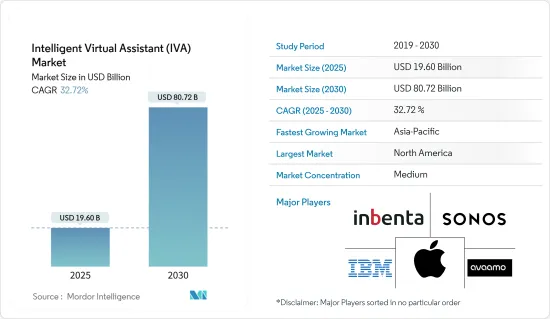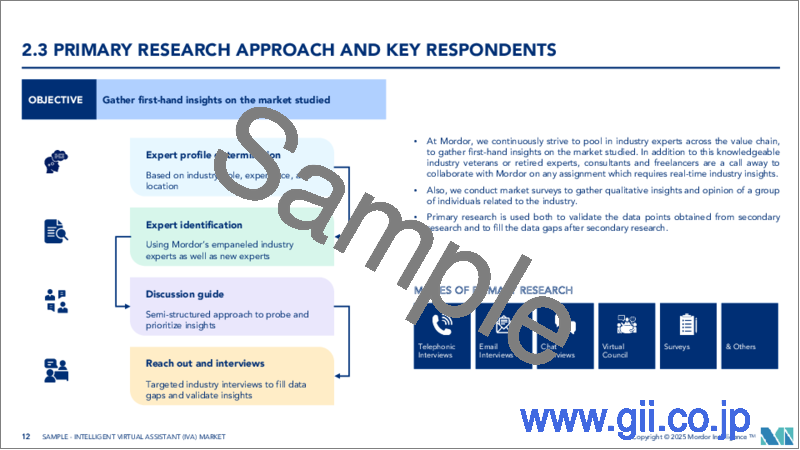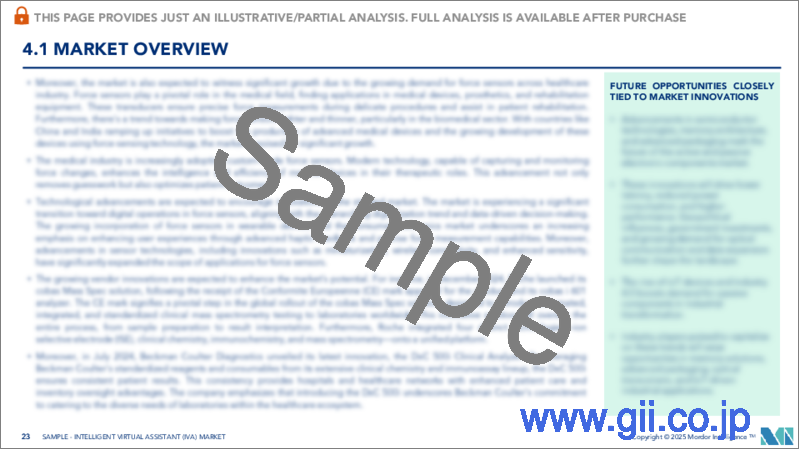|
|
市場調査レポート
商品コード
1645138
インテリジェントバーチャルアシスタント(IVA):市場シェア分析、産業動向・統計、成長予測(2025年~2030年)Intelligent Virtual Assistant (IVA) - Market Share Analysis, Industry Trends & Statistics, Growth Forecasts (2025 - 2030) |
||||||
カスタマイズ可能
適宜更新あり
|
|||||||
| インテリジェントバーチャルアシスタント(IVA):市場シェア分析、産業動向・統計、成長予測(2025年~2030年) |
|
出版日: 2025年01月05日
発行: Mordor Intelligence
ページ情報: 英文 120 Pages
納期: 2~3営業日
|
全表示
- 概要
- 目次
インテリジェントバーチャルアシスタント(IVA)の市場規模は2025年に196億米ドルと推定され、予測期間(2025-2030年)のCAGRは32.72%で、2030年には807億2,000万米ドルに達すると予測されます。

主なハイライト
- ディープニューラルネットワーク、機械学習、その他のAIの進歩が、より多くのバーチャルアシスタントを可能にしています。チャットボットとスマートスピーカーは、小売、BFSI、ヘルスケアなどのエンドユーザー産業で利用されているバーチャルアシスタントの2つの例です。パーソナルアシスタントとして機能するバーチャルアシスタントは、消費者向けの重要な形態です。アップルのSiriの助けを借りたり、接続された家庭や自動車に使いやすいインターフェースを提供することで、ユーザーが様々な雑用をこなすのを助ける。
- また、バーチャル・アシスタントが顧客サービス・エージェントの役割を果たすことも増えています。企業にとってバーチャルアシスタントは、より消費者に優しいアプローチで顧客やブランドの体験を向上させる。例えば、クラウドコンタクトセンターのプロバイダーであるFive9は、Inference Solutionsと提携してFive9バーチャルアシスタントを立ち上げました。このシステムは会話型人工知能を活用し、手作業を自動化し、コンタクトセンターでよくある質問に答えます。
- 例えば、ヘルスケア業界では、バーチャルアシスタントは、顧客が医院を探すのを手伝ったり、処方箋の記入や補充をしたり、支払いのリマインダーを受け取ったりすることができます。
- ヘルスケア業界全体で認知されているバーチャル・アシスタントには、アップルのSiri、マイクロソフトのCortana、グーグルのアシスタントなどがあります。中小企業もインテリジェントバーチャルアシスタント(IVA)の背後にある技術を推進しており、健康インテリジェントバーチャルアシスタント(IVA)の重要な部分を担っています。例えば、Next ITのAlme of Healthcareは、慢性疾患の管理に重点を置き、患者の質問や要望に積極的に答えるバーチャルアシスタントです。これは現在、ヘルスケア・プロバイダーによって大規模に採用されています。
- ヘルスケア以外では、小売企業も人気のメッセージングアプリでチャットボットを使用し、顧客により良い体験を提供しています。Domino'sやその他の店舗では、AIと機械学習を使ってチャットボットのようなバーチャルアシスタントを動かしており、顧客はFacebook Messengerを通じて直接注文を行うことができます。
- 2020年春のスマートオーディオレポートでは、COVID-19の発生により、米国の成人の約77%が通常のルーチンを変更したことが確認されました。このような変化の中で、音声アシスタントを利用する人が増え、市場成長には好材料となった。
- 企業もまた、このような不確実な時代に人々が意識を保つのに役立つ製品を展開しています。例えば、会話型インターフェイスを専門とするディープラーニング・ソフトウェア企業で、ウィプロ・ベンチャーズの支援を受けるアヴァーモ(Avaamo)は、プロジェクトCOVIDを立ち上げました。COVID-19インテリジェントバーチャルアシスタント(IVA)は、誰でも使用でき、平易な英語で素早く答えを見つける手助けをします。
インテリジェントバーチャルアシスタント(IVA)市場動向
スマートスピーカーが市場成長を牽引
- 現在、スマートスピーカーに期待される機能には、音楽再生やスマートホームデバイスの制御などがあります。スマートスピーカーの増加により、音声アシスタントは、接続されたユーザーの生活により多くの有用性をもたらすと考えられています。短期間のうちに、音声起動スピーカーは人々の日課の一部となった。その理由としては、マルチタスクをこなしながらテクノロジーを使用できること、人々はタイプするよりも早く話すという事実(スピード)、ヒューマン・インターフェースの増加などが挙げられます。
- さらに、消費者は手頃な価格でハイエンドの機能が詰まった製品を好むことが多いです。ホールフーズの店舗でのプロモーション戦術や、ウェブとテレビコマーシャルの両方でアレクサに焦点を当てた広告により、アマゾン・アレクサは消費者の間で絶大な勢いを獲得しました。アマゾンはまた、競争力を得るために、いくつかの製品の価格を引き下げました。
- 例えば、NPR、ロイター、ニューヨーク・タイムズ、CNNなどの出版社や、テネシアン、インディスター、テキサス・トリビューンなどのローカル・ニュース・プロバイダーは、スマート・スピーカーで聞けるように設計された短い音声ブリーフィングを作成しています。
最も有名なスマート・スピーカーは、アマゾン・エコーとグーグル・ネストの製品群だが、ソノス・ワンなど、アレクサとグーグル・アシスタントの両方を内蔵したサードパーティ製スピーカーも数多くあります。これらの企業は、増大する市場の需要に応えるために新製品を投入しています。スマートスピーカーは、FMCGや食料品のeコマースの次の波を牽引すると予測されています。企業は音声技術をより広範なクロスチャネル戦略に統合することを考えています。
北米が大きなシェアを占める見込み
- 同地域のミレニアル世代の多くはセルフサービス・オプションやメッセージング・アプリを好むため、同地域の企業は彼らのニーズを満たすためにIVAサービスを選択する可能性が高く、同地域の市場成長を後押しします。
- 同地域の堅調な銀行部門とヘルスケア部門は、顧客のパーソナライゼーションのためにチャットボットに積極的に投資しています。銀行分野でAI支援チャットボットをいち早く採用したのは北米の企業です。
- 例えば、同市場の有力プレーヤーであるニュアンス・コミュニケーションズは、米国の臨床医1万人のうち80%が、バーチャルアシスタントが今後数年で医療を劇的に変えると考えていることを明らかにしました。このようなセルフサービス・オプションに対する消費者の高い志向は、メッセージング・アプリケーションの成長につながり、地域全体でIVAチャットボットの採用に有利な環境が整っていることを示しています。
- また、企業は自動意思決定システムをサポートするために、AIや機械学習の助けを借りてIVA技術の改善に多くの資金を投入しています。最近、アマゾンはAmazon Voice Services APIに通知機能を追加しました。そのため、この最新の音声通知機能により、アレクサはショッピングの最新情報、今後のオファー、ショッピング・フェスティバルの詳細、その他多くの最新情報など、いくつかの新しいコンテンツを示すことができます。このような音声検索通知は、今後数年間で最新の動向になると予想されます。
- 米国は依然としてスマートスピーカー普及の重要な市場です。NPRの最新のスマートオーディオレポートによると、アメリカ人(18歳以上)の約24%が少なくとも1台のスマートスピーカーを所有しており、平均的な所有者は複数台を持っています。アメリカ人の大半がAlexaを所有しています。アマゾンがエコー(Echo)を発表して以来、エコーは米国で人気を博し、他のトップクラスの競合他社に挑んでいます。
インテリジェントバーチャルアシスタント(IVA)業界概要
インテリジェントバーチャルアシスタント(IVA)市場の競争は中程度で、複数の大手企業が存在します。市場シェアでは、現在、一部のプレーヤーが市場を独占しています。しかし、音声とジェスチャーの統合認識技術の進歩に伴い、新たなプレーヤーが市場での存在感を高め、新興国での事業展開を拡大しています。最近の市場開拓の動向をいくつか紹介する:
2022年9月、顧客とのやり取りを自動化するプラットフォームを製造するeGain Corporationは、IBM Watson Assistant用の構築済みコネクターが利用可能になったと発表しました。これはIBMとの提携によるものです。このコネクターはeGain独自のBYOBTM(Bring Your Own Bot)アーキテクチャを採用しており、Watson AssistantとeGainプラットフォームとの統合を、ビジネス・ユーザーにとって簡単でコード不要なものにします。
その他の特典:
- エクセル形式の市場予測(ME)シート
- 3ヶ月間のアナリストサポート
目次
第1章 イントロダクション
- 調査の前提条件
- 調査範囲
第2章 調査手法
第3章 エグゼクティブサマリー
第4章 市場洞察
- 市場概要
- 業界の利害関係者分析
- 業界の魅力度-ポーターのファイブフォース分析
- 供給企業の交渉力
- 消費者の交渉力
- 新規参入業者の脅威
- 代替品の脅威
- 競争企業間の敵対関係の強さ
- 産業バリューチェーン分析
- 技術スナップショット
- バーチャルアシスタント(IVA)市場への影響評価
第5章 市場力学
- 市場促進要因
- プロフェッショナルサービスにおける顧客体験向上への注目の高まり
- スマートスピーカーが市場成長を牽引
- 市場抑制要因
- 生身の人間との対話への嗜好の高まり
第6章 市場セグメンテーション
- 製品別
- チャットボット
- スマートスピーカー
- ユーザーインターフェース別
- Text-to-Text
- Text-to-Speech
- 自動音声認識
- エンドユーザー別
- チャットボット
- 小売
- BFSI
- ヘルスケア
- テレコム
- 旅行・ホスピタリティ
- その他のエンドユーザー産業
- スマートスピーカー
- 個人
- 商業
- チャットボット
- 地域別
- 北米
- 米国
- カナダ
- 欧州
- ドイツ
- 英国
- フランス
- スペイン
- その他欧州
- アジア太平洋
- 中国
- 日本
- インド
- その他アジア太平洋地域
- ラテンアメリカ
- ブラジル
- アルゼンチン
- その他ラテンアメリカ
- 中東・アフリカ
- アラブ首長国連邦
- サウジアラビア
- 南アフリカ
- その他中東とアフリカ
- 北米
第7章 競合情勢
- 企業プロファイル
- Avaamo Inc.
- EdgeVerve Systems Limited(An Infosys Company)
- SMOOCH.ai
- Inbenta Technologies Inc.
- Creative Virtual Ltd.
- Serviceaide Inc.
- Ipsoft Inc.
- Kore.ai Inc.
- IBM Corporation
- スマートスピーカーベンダー
- Amazon.com Inc.
- Google LLC(Alphabet Inc.)
- Alibaba Group
- Sonos Inc.
- Harman-Kardon Inc
- Apple Inc.
- Bose Corporation
- Xiaomi Inc.
- Baidu Inc.
第8章 投資分析
第9章 市場の将来展望
The Intelligent Virtual Assistant Market size is estimated at USD 19.60 billion in 2025, and is expected to reach USD 80.72 billion by 2030, at a CAGR of 32.72% during the forecast period (2025-2030).

Key Highlights
- Deep neural networks, machine learning, and other advances in AI are making more virtual assistants possible. Chatbots and smart speakers are two examples of virtual assistants that are used in retail, BFSI, and healthcare, among other end-user industries. A virtual assistant acting as a personal assistant is a significant consumer-facing form. With the aid of Apple's Siri or by providing an easy-to-use interface for connected homes or autos, it aids users in completing various chores.
- Another use on the rise is virtual assistants adopting the customer service agent role. For enterprises, virtual assistants improve customer and brand experiences with a more consumer-friendly approach. For example, Five9, a cloud contact center provider, launched Five9 Virtual Assistant in partnership with Inference Solutions. The system leverages conversational artificial intelligence to automate manual tasks and answer common questions in the contact center.
- The capabilities of these assistants can also be changed based on the end user, which makes the customer experience better in a certain industry.For example, in the healthcare industry, a virtual assistant can help a customer find a doctor's office, fill and refill a prescription, and get payment reminders.
- Some virtual personal assistants that have gained recognition across the healthcare sector are Apple's Siri, Microsoft's Cortana, and Google's Assistant. Small and medium-sized businesses also drive the technology behind intelligent virtual assistants, making them important parts of health-intelligent virtual assistants. For example, Next IT's Alme of Healthcare is a virtual assistant that focuses on managing chronic diseases and actively answers patients' questions and requests. This is currently being adopted on a massive scale by healthcare providers.
- Aside from healthcare, retail companies also use chatbots in popular messaging apps to give their customers a better experience.Domino's and other stores use AI and machine learning to power virtual assistants like chatbots, which let customers place orders directly through Facebook Messenger.
- The Spring 2020 Smart Audio Report confirmed that the COVID-19 outbreak caused about 77% of US adults to change their normal routines. During these changes, more people used voice assistants, which was good for market growth.
- Companies are also rolling out offerings that help people stay aware of these uncertain times. For example, Avaamo, a deep-learning software company that specializes in conversational interfaces and is backed by Wipro Ventures, launched Project COVID, a COVID-19 Intelligent Virtual Assistant that can be used by anyone and helps find answers quickly in plain English.
Intelligent Virtual Assistant (IVA) Market Trends
Smart Speakers to Drive the Market Growth
- The characteristics expected from a smart speaker nowadays include playing music and controlling smart home devices. An increasing number of smart speakers is believed to give voice assistants more utility in a connected user's life. In a short period of time, voice-activated speakers have become a part of people's routines. Reasons for this include the ability to use the technology while multitasking, the fact that people speak more quickly than they type (speed), and increasing human interfaces.
- Further, consumers frequently like products that are both affordable and packed with high-end features. Due to its promotional tactics at a Whole Foods store and Alexa-focused advertisements on both the web and television commercials, Amazon Alexa achieved tremendous momentum among consumers. Amazon also lowered the price of several of its products to obtain a competitive edge.
- Publishers and media companies are trying out new content and ways for smart speakers to interact with it.For instance, publishers like NPR, Reuters, the New York Times, CNN, and local news providers, such as the Tennessean, IndyStar, and Texas Tribune, are all creating short audio briefings designed to be heard on smart speakers.
Among the most well-known smart speakers are the Amazon Echo and Google Nest ranges of products, but there are plenty of third-party speakers, like the Sonos One, which come with both Alexa and Google Assistant built-in. These companies are rolling out new products to cater to the increasing market demand. Smart speakers are forecast to drive the next wave of FMCG and grocery e-commerce. Companies are thinking of integrating voice technology into a broader cross-channel strategy.
North America is Expected to Hold a Major Share
- Since many millennials in the region prefer self-service options and messaging apps, businesses in the region are likely to choose IVA services to meet their needs, which will help the market grow in the region.
- The region's robust banking and healthcare sectors have actively invested in chatbots for customer personalization. The early adopters of AI-assisted chatbots in the banking sector are from North America.
- For instance, Nuance Communications, a prominent player in the market, revealed that 80% of 10,000 US clinicians believe virtual assistants will drastically change healthcare in the next few years. Such high consumer inclination toward self-service options has led to the growth of messaging applications, indicating the favorable environment for adopting IVA chatbots across regions.
- Also, companies are putting more money into improving IVA technology with the help of AI and machine learning to support automated decision-making systems. This is expected to drive the market across the region.Recently, Amazon added a notification capability to the Amazon Voice Services API. Therefore, this latest voice notification feature allows Alexa to indicate some new content, such as shopping updates, upcoming offers, shopping festival details, and many other updates. These voice search notifications are expected to become the latest trend in the coming years.
- The US remains an important market for smart speaker adoption. According to the latest Smart Audio Report from NPR, around 24% of Americans (18+) own at least one smart speaker, and the average owner has more than one. The majority of Americans own Alexa. Since Amazon first introduced the Echo, it has become popular in the United States, challenging other top competitors.
Intelligent Virtual Assistant (IVA) Industry Overview
The intelligent virtual assistant market is moderately competitive and has several significant players. In terms of market share, some of the players currently dominate the market. However, with the advancement of integrated speech and gesture recognition technologies, new players are increasing their market presence and expanding their business footprint across emerging economies. Some of the recent developments in the market are:
In September 2022, eGain Corporation, which makes a platform for automating customer interactions, said that a pre-built connector for IBM Watson Assistant was available. This was done in partnership with IBM. The connector uses eGain's unique BYOBTM (Bring Your Own Bot) architecture to make integrating the Watson Assistant with the eGain platform easy and code-free for business users.
Additional Benefits:
- The market estimate (ME) sheet in Excel format
- 3 months of analyst support
TABLE OF CONTENTS
1 INTRODUCTION
- 1.1 Study Assumptions
- 1.2 Scope of the Study
2 RESEARCH METHODOLOGY
3 EXECUTIVE SUMMARY
4 MARKET INSIGHTS
- 4.1 Market Overview
- 4.2 Industry Stakeholder Analysis
- 4.3 Industry Attractiveness - Porter's Five Forces Analysis
- 4.3.1 Bargaining Power of Suppliers
- 4.3.2 Bargaining Power of Consumers
- 4.3.3 Threat of New Entrants
- 4.3.4 Threat of Substitute Products
- 4.3.5 Intensity of Competitive Rivalry
- 4.4 Industry Value Chain Analysis
- 4.5 Technology Snapshot
- 4.6 Assessment of COVID-19 Impact on the Intelligent Virtual Assistant (IVA) Market
5 MARKET DYNAMICS
- 5.1 Market Drivers
- 5.1.1 Increasing Focus to Improve Customer Experience across Professional Services
- 5.1.2 Smart Speakers to Drive the Market Growth
- 5.2 Market Restraints
- 5.2.1 Increasing Preference for Live Person Interaction
6 MARKET SEGMENTATION
- 6.1 By Product
- 6.1.1 Chatbots
- 6.1.2 Smart Speakers
- 6.2 By User Interface
- 6.2.1 Text-to-Text
- 6.2.2 Text-to-Speech
- 6.2.3 Automatic Speech Recognition
- 6.3 By End-User
- 6.3.1 Chatbots
- 6.3.1.1 Retail
- 6.3.1.2 BFSI
- 6.3.1.3 Healthcare
- 6.3.1.4 Telecom
- 6.3.1.5 Travel and Hospitality
- 6.3.1.6 Other End-User Industries
- 6.3.2 Smart Speakers
- 6.3.2.1 Personal
- 6.3.2.2 Commercial
- 6.3.1 Chatbots
- 6.4 By Geography
- 6.4.1 North America
- 6.4.1.1 United States
- 6.4.1.2 Canada
- 6.4.2 Europe
- 6.4.2.1 Germany
- 6.4.2.2 United Kingdom
- 6.4.2.3 France
- 6.4.2.4 Spain
- 6.4.2.5 Rest of Europe
- 6.4.3 Asia Pacific
- 6.4.3.1 China
- 6.4.3.2 Japan
- 6.4.3.3 India
- 6.4.3.4 Rest of Asia Pacific
- 6.4.4 Latin America
- 6.4.4.1 Brazil
- 6.4.4.2 Argentina
- 6.4.4.3 Rest of Latin America
- 6.4.5 Middle East and Africa
- 6.4.5.1 UAE
- 6.4.5.2 Saudi Arabia
- 6.4.5.3 South Africa
- 6.4.5.4 Rest of Middle East and Africa
- 6.4.1 North America
7 COMPETITIVE LANDSCAPE
- 7.1 Company Profiles
- 7.1.1 Avaamo Inc.
- 7.1.2 EdgeVerve Systems Limited (An Infosys Company)
- 7.1.3 SMOOCH.ai
- 7.1.4 Inbenta Technologies Inc.
- 7.1.5 Creative Virtual Ltd.
- 7.1.6 Serviceaide Inc.
- 7.1.7 Ipsoft Inc.
- 7.1.8 Kore.ai Inc.
- 7.1.9 IBM Corporation
- 7.2 Smart Speaker Vendors
- 7.2.1 Amazon.com Inc.
- 7.2.2 Google LLC (Alphabet Inc.)
- 7.2.3 Alibaba Group
- 7.2.4 Sonos Inc.
- 7.2.5 Harman-Kardon Inc
- 7.2.6 Apple Inc.
- 7.2.7 Bose Corporation
- 7.2.8 Xiaomi Inc.
- 7.2.9 Baidu Inc.





